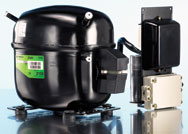The refrigeration system in a commercial ice machine typically includes a thermal expansion valve (TXV)-fed evaporator, compressor, condenser, and a hot gas solenoid valve that bypasses the condenser and the TXV so that hot gas can be briefly circulated in the evaporator to free the cubes during the harvest phase of the operating cycle.
HOW ICE MACHINES WORK
The mechanics of ice cube production and harvesting vary. Many machines use an evaporator that is constructed by brazing tubing to one side of a plate. The other side of the plate has a grid of cube-sized compartments into or over which pure water flows. There are various means of sensing when the cubes are ready for harvest. As cubes are formed they are harvested and received into a bin.(For convenience, we are discussing cube machines in this article. Flakers and nugget machines form their product differently, though similar refrigeration components are used.)
Electrical and mechanical designs of these machines vary, and are best studied from the manufacturer's manuals. The refrigeration system components found are common to all designs. Each manufacturer's design includes an electronic controller that regulates every phase of the operation. Many newer machines have control electronics that provide troubleshooting indications.
Until the receiving bin is full, water flows to the machine's evaporator plate during the production phase. When the sensing system indicates that cubes are fully formed, the hot gas solenoid opens, the evaporator warms, cubes are freed and harvested, and the cycle begins again.

The solenoid valve used for hot gas bypass must be as nearly leakproof internally as possible, with a high maximum operating pressure differential (MOPD). Even the smallest leakage during ice production increases the heat load on the evaporator, resulting in a longer freeze cycle.
Another ugly problem results from a solenoid valve that is not perfectly tight. In addition to wasting energy, the extended freeze cycle brought about by any amount of hot gas being introduced downstream of the expansion valve causes the formation of cloudy ice rather than the crystal clear product expected. The rate of cube production is also considerably lowered as a result of a leaking solenoid valve.
In addition to tightness, the hot gas solenoid valve must have a high MOPD. Close to the end of the freezing cycle, with the entire evaporator insulated by ice, suction pressure is very low. Condensing pressure is high. At that time, just before harvest, the solenoid valve must open against the high-pressure differential to release the hot gas that will free the cubes from the evaporator.
This is why a high MOPD is important. The tightness and high MOPD requirements are also reasons that hermetic, non-serviceable solenoid valves are often found in ice machines.
The compressor selected for an ice machine should be built for the specific application. Modifications to standard design are used by some OEMs. For all ice machine applications, it is beneficial if the design tolerates some liquid return to the compressor.

TROUBLESHOOTING
As with any commercial appliance, there are key procedures to follow in troubleshooting ice machine refrigeration problems.On every call, if the machine is running, observe its system through a complete cycle. Many newer machines have lights on their control electronics boards that offer flash patterns or other indications to assist in troubleshooting. Use the supplied chart or manual for interpretation and troubleshooting indications.
Make a thorough overall inspection of the system. Check condenser fan operation. Make sure that the condenser is clean. Has the machine been moved recently or since your last visit? Ensure that there is adequate air circulation around the machine to allow rejection of heat, both from the condenser and compressor. The machine should not be located in a corner, nor should it be enclosed. There should not be material stacked close by, preventing good airflow.
Check for subcooling: With the machine operating and the solenoid valve closed, make sure that there is liquid getting to the TXV. Measure the tubing temperature ahead of the TXV. At the same time, determine the saturated condensing temperature. This is done by finding the pressure at the discharge port and then using a pressure-temperature chart or refrigeration slide rule to determine the saturated discharge temperature that corresponds to the discharge pressure.
The difference between the liquid temperature and the saturated discharge temperature is the amount of subcooling. There must be subcooling for the TXV to meter refrigerant into the evaporator properly.
Check the solenoid valve: Ex-amine the solenoid valve. If the valve body remains hot after the freezing cycle is well underway, it is leaking hot gas and should be replaced with a new valve. Remember that a leaking valve results in lower cube production and imperfect cubes because of an extended freeze cycle.
Problem with the TXV? If there is subcooling, low suction pressure and no ice production, then the TXV is faulty and must be replaced. Always obtain an exact equivalent replacement and locate the sensing bulb exactly where the original bulb was placed by the machine manufacturer.
Check the compressor: If the machine does not run, power is reaching the compressor's terminals, and switches are good, the compressor probably needs to be changed out. Make sure it is replaced with an equivalent compressor. In many cases an exact replacement is necessary.
Ice machines, under the heavy demands placed upon them by their users, generally have a service life of more than 10 years if properly maintained. It makes good service and business sense to give attention to the machine on any service visit, whether for the beverage system or another refrigeration appliance. Inquire about its performance and take appropriate action if indicated.
For more information, visit www.danfoss.com.
Publication date: 07/03/2006

Report Abusive Comment